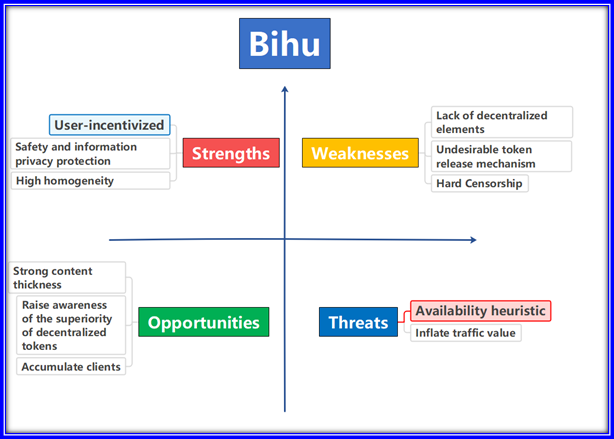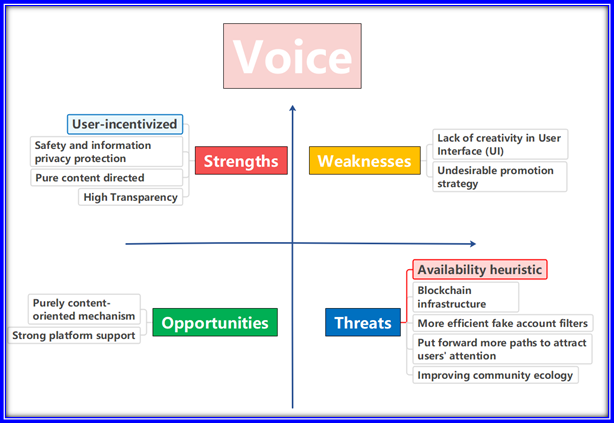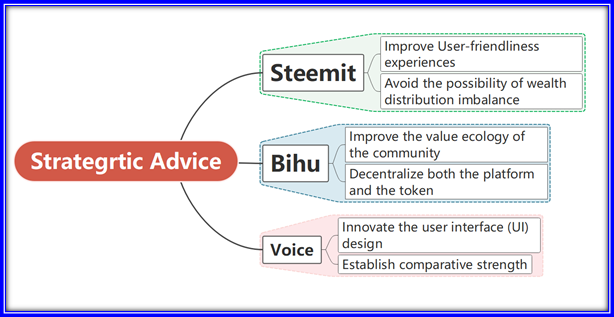How Blockchain Empowers Social Media: on the mechanics of token economy and decentralization? [Part 2 The Business Model Analysis]
— Stories behind three typical paradigms: Steemit, Bihu, and Voice
Executive summary about tokenized social media
Nowadays, users have an increasing demand for decentralized platforms when censorship, privacy disclosure, and security of personal data are severely concerned in traditional social media. The innovative blockchain technology perfectly solves this dilemma by reducing the trust cost, protecting users’ freedom of expression, and serving as a reliable framework of the peer-to-peer (P2P) network.
Taking a further step, a few social media companies have introduced the token system into their platforms. Tokenized social media connects the platform and users through their consensus on the token value. Moreover, the token economy incentivizes users to contribute their intelligence to the virtual community and participate in on-chain governance. In this article, we will introduce three typical tokenized social media, Steemit, Bihu, and Voice, in facets of their business models, token design, as well as insightful analysis about its strengths, weaknesses, opportunities, and threats (SWOT). Finally, we will discuss how tokenized social media revolutionizes the online communication ecology and builds the future community of diversity and inclusion.
To recap, in Part 1, we introduce briefly the three trending tokenized social media. Now in Part 2, let’s take a closer look into the business model and conduct SWOT Analysis [1]. We are also providing strategic advice for further development.
Part II The Business Model Analysis
I. The business models
To win market shares from traditional social media, blockchain start-ups should build up their business models, by considering both their clients’ demands and expectations, as well as the product’s profit margins. So let’s dive into their business models to find out their similarities and disparities from their strengths.

Figure 1: Mind map of business model analysis
1 Similarity
a) Built on blockchain: no intermediary (and thus low cost), transparency, anonymity, exclusive ownership of data.
DeFi applications do not need any intermediaries or arbitrators. The code specifies the resolution of every possible dispute, and the users maintain control over their funds at all times. This reduces the costs associated with providing and using these products and allows for a more frictionless financial system.
b) User-incentivized (Autofilter[2])
Users receive tokens by registering, producing posts, liking/commenting posts, or watching advertisements.
Information recommendation: Good posts (with high likes/comments) delivered to users
c) Cash user attention; Alignment between the platform and users (ads)
Traditionally, users are forced to view advertisements on centralized social media. All advertisement fees are obtained by the platform owners whereas users cannot benefit from the time they spent watching the ads. One major improvement of decentralized social media is to change the unequal position of the platform and users by rewarding tokens to those who watch the advertisements. For example, Bihu only took 55% of advertisement fees, the rest 45% is rewarded to users after watching an advertisement.

Figure 2: Logo of Bihu, Steemit, and Voice
2 Disparities
a) Bihu is subject to censorship and manipulation (because of its centralized platform and enforcement of Chinese laws/regulations), while Steemit and Voice are more decentralized.
b) Steemit has low user-friendliness (complicated three-currency mechanism; anchoring mechanism of STEEM), while Bihu and Voice has a lower threshold as each of them only contains one currency and has a clear token structure.
c) Bihu and Steemit have a weight mechanism in token distribution: those who own more tokens could receive a higher proportion of new tokens. However, the token delivery in Voice has nothing to do with current wealth. The content quality determines the number of tokens that the creators can acquire.
II. SWOT analysis and strategic advice
In this session, we apply SWOT analysis for comparative studies. Moreover, we provide strategic advice to further advance each decentralized social media.

Figure 3: Diagram of SWOT about Steemit
Figure 4: Diagram of SWOT about Bihu
Figure 5: Diagram of SWOT about Voice
1. Strengths
There is one common strength among these three different tokenized social media, which is summarized as “User-incentivized”, where users could receive corresponding tokens by registering, producing posts, liking/commenting posts, or watching advertisements. Besides, some distinct strengths are also covered in these social media, and the concrete information is shown below:
Steemit
1. Safety and information privacy protection: This platform guarantees the exclusive ownership of data.
2. Approachable token design mechanism: The mining mechanism is generated through traditional community behavior.
3. User-friendly settings: Only to construct a simple and easy-to-remember account.
Bihu
1. Safety and information privacy protection: This platform guarantees the exclusive ownership of data.
2. High homogeneity: Ads are used to maintain the alignment between the platform and users.
Voice
1. Safety and information privacy protection: This platform guarantees the exclusive ownership of data.
2. Pure content directed: Voice tokens have no staking weight.
3. High Transparency: Voice is fully on-chain, and all user behaviors are on-chain, which is much easier to be governed.
2. Weaknesses
Their strengths are alike, their weakness differs in the extent of centralization, token mechanism, and way of promotion.
Steemit
1. Complicated token design mechanism: Differences between these three types of tokens always confuse people, and may result in the loss of the user group to a large extent.
2. Possible monopoly trend in the user group: The main share of STEEM is controlled by a small number of people, and the benefits of user posts are not directly linked to the quality of the article but those who own currencies, which would result in terrible problems of the community ecology.
3. Inappropriate and unequal functions of tokens: In this project, more tokens means higher voting weight, which results in a terrible opportunities inequality.
Bihu
1. Lack of decentralized elements: This social media is still a relatively centralized platform application, where designers are still capable of monitoring and controlling the release of users’ contents.
2. Undesirable token release mechanism: Lock-up mechanism would enhance the wealth gap on the basis of the time those clients enter this platform.
3. Hard Censorship: China is still monitoring the series of behaviors on a regular basis and lays emphasis on the centralized censorship system in this application.”
Voice
- Lack of creativity in User Interface (UI): Its design is quite similar to that in the traditional social media platform.
2. Undesirable promotion strategy: It’s hard for clients to get access to this social media with common proxies to know more about this platform.
3. Opportunities
Though having the weaknesses above, there are fairly many opportunities that they can grasp to take their unique place in the market.
Steemit
- Large amount of funds and high expectation from the investors: Steemit, as one of the origins of tokenized social media, is given high expectations from the investors, and expected to update based on its own inner strength of its business model.
Bihu
1. Strong content thickness: In this community, blockchain fans could easily be attracted to share what to buy, as well as when to buy and sell with blockchain investment.
2. Raise awareness of the superiority of decentralized tokens: Application of decentralized token in social media apps in the China market has been more discussed in the academic than industry area.
3. Accumulate clients: Users tend to believe in the value and development of KEY, which combine the platform and users to be parallel on the same page.
Voice
1. Purely content-oriented mechanism: Amount of token rewards mainly depends on the number of “”likes”” and the number of readings, nothing to do with the number of tokens the user already holds.
2. Strong platform support: Official version of Voice will be based on EOS IO[3].
4. Threats
In terms of threats, we first observe that one principle from behavioral economics called the “Availability heuristic” [4] could be perceived as one of the most serious threats among three social media. This means that people are easy to be biased by blockchain hot, the direct value of tokens, as well as some benefit cases of existing users.
Steemit
Inaccurate estimation of contribution abilities of equity owners: Developers cannot accurately estimate the genuine contribution from every equity owner when it comes to decision-making processes and long-term development of the whole community.
Bihu
Inflate traffic value: Large user group provides base for advertisement, and it might cover some inherent problems in the system itself.
Voice
1. Blockchain infrastructure: Developers still cannot maintain its transparency, trust, security, and they should also find a solution to combat systematic manipulation
2. More efficient fake account filters: Verification through the developing Know Your Customer System (KYC) would behave more stable and efficient than the existing algorithms.
3. Put forward more paths to attract users’ attention: User attention is distributed in the form of smart tokens, so it is necessary to develop more paths to motivate the users in the community.
4. Improving community ecology: It is necessary to construct a better development team and community to evolve Voice products.
5. Strategic Advice

Figure 6: Mind map of strategic advice
Steemit
1. Improve User-friendliness experiences: Find a strategy to describe the complicated three-token mechanism or polish up this mechanism in a simpler way.
2. Avoid the possibility of wealth distribution imbalance: 1 in 1000 people account for more than 75% of Steem Power, which exacerbates the wealth gap, where the rich have a stronger right to speak, and results in an undesirable community ecology.
Bihu
1. Improve the value ecology of the community: KEY is backed up with actual use value in the ecology.
2. Decentralize both the platform and the token: Now Bihu only has a decentralized token but the platform is still centralized as they claimed that the blockchain technology is not able to support high-speed computation that a social media platform requires.
Voice
1. Innovate the user interface (UI) design: Create a unique UI to attract potential customers and clients.
2. Establish comparative strength: Highlight its unique strength compared to steemit when making promotions, intros, etc., otherwise people might be stuck in straightforward thinking that it is just derived from the previous version of tokenized social media.
Notes
[1] SWOT Analysis:
SWOT stands for Strengths, Weaknesses, Opportunities, and Threats, and so a SWOT Analysis is a strategy for assessing these four aspects of business product. Here we apply SWOT Analysis to facilitate a realistic, fact-based, data-driven look at the strengths and weaknesses of an organization, initiatives, or within its industry.
[2] Autofilter:
Due to the reward system embedded in the smart contract, the client group would spontaneously filter the convincing and quality information, thus it does not require upper governance to screen and examine specific contents, which creates an intelligent society ecology.
[3] EOS IO:
EOS IO is a highly performant open-source blockchain platform, built to support and operate safe, compliant, and predictable digital infrastructures.
[4] Availability Heuristics
The availability heuristic, also known as availability bias, is a mental shortcut that relies on immediate examples that come to a given person’s mind when evaluating a specific topic, concept, method or decision. The availability heuristic operates on the notion that if something can be recalled, it must be important, or at least more important than alternative solutions which are not as readily recalled.
Acknowledgments:
Authors: Ray Zhu, Tianyu Wu
Design: Austen Li
Assistant Editor: Zichao Chen
Associate Editor: Xinyu Tian; Executive Editor: Lunji Zhu
Chief Editors: Prof. Luyao Zhang, Prof. Yulin Liu